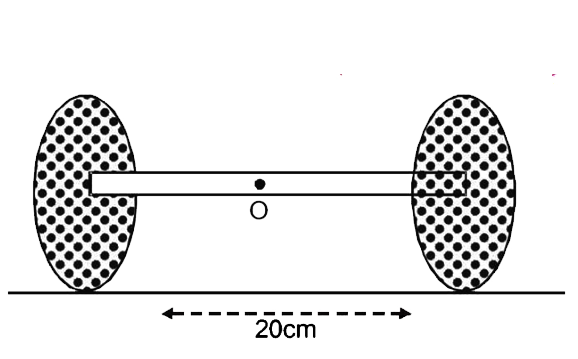A helicopter of mass 1000 kg rises with a vertical acceleration of 15ms−2 . The crew and the passengers weigh 300 kg . Give the magnitude and direction of the
(a) force on the floor by the crew and passengers
(b) action of the rotor of the helicopter on the surroundings air :
(c ) force on the helicopter due to the surroundings air :
Here, mass of the helicopter, m1=1000kg
Mass of the crew and passengers
m2=300kg
Upward acceleration a=15ms−2 and g=10ms−2
(a) Force on the floor of helicopter by the crew and passenger = appeared weight of crew and passengers
=m2(g+a)
=(1000+300)(10+15)
=1300×25=32500N
(c ) Force on the helicopter due to surrounding air is the reaction. As action and reaction are equal and opposite, therefore, force of reaction F1=32500N, vertically upwards.
Topper's Solved these Questions
- BOOK - AAKASH SERIESCHAPTER - LAWS OF MOTIONEXERCISE - Application6videos
LAWS OF MOTION
- BOOK - AAKASH SERIESCHAPTER - LAWS OF MOTIONEXERCISE - EXERCISE - I157videos
LAWS OF MOTION
- BOOK - AAKASH SERIESCHAPTER - LAWS OF MOTIONEXERCISE - QUESTIONS FOR DESCRIPTIVE ANSWER5videos
LAWS OF MOTION
- BOOK - AAKASH SERIESCHAPTER - GEOMETRICAL OPTICSEXERCISE - ADDITIONAL PRACTICE EXERCISE (LEVEL-II PRACTICE SHEET (ADVANCED) INTEGER TYPE QUESTIONS)10videos
GEOMETRICAL OPTICS
- BOOK - AAKASH SERIESCHAPTER - LOGIC GATESEXERCISE - Exercise (Very Short Answer)10videos
LOGIC GATES
Similar Questions
A helicopter of mass 1000 kg rises with vertical acceleration of 15ms−1. The crew and the passengers weigh 300 kg. Give the magnitude and direction of the
a) force on the floor by the crew and passengers
b) action of the rotor of the helicopter on the surrounding air
c) force on the helicopter due to the surrounding airView SolutionA helicopter of mass 2000 kg rises with a vertical acceleration of 15ms−2. The total mass of the crew and passengers is 500 kg. Give the magnitude and direction of the (g=10ms−2)
(a) Force on the floor of the helicopter by the crew and passengers.
(b) action of the rotor of the helicopter on the surrounding air.
(c ) force on the helicopter dur to the surrounding air.View Solution
Knowledge Check
- Question 1 - Select One
A helicopter of mass 2000 kg rises with a vertical acceleration of 15ms−2. The total mass of the crew and passengers is 500 kg. Give the magnitude and direction of the (g=10ms−2)
(a) Force on the floor of the helicopter by the crew and passengers.
(b) action of the rotor of the helicopter on the surrounding air.
(c ) force on the helicopter dur to the surrounding air.AI and iiBii and iiiCI and iiiDAll the three
A body of mass 40 kg stands on a weighing machine in an accelerated lift. The reading on the scale of the weighing machine is 300 N. Find the magnitude and direction of acceleration. (g=9.8ms−2)
View SolutionDue to the application of a force on a body of mass 100 kg that is initially at rest, the body moves with an acceleration of 20ms−2 in the direction of the force. Find the magnitude of the force.
View SolutionA constant horizontal force of 10N is applied at the centre of a wheel of mass 10kg and radius 0.30m. The wheel rolls without slipping on the horizontal surface, and the acceleration of the centre of mass is 0.60m/s2.
a. What are the magnitude and direction of the frictional force on the wheel?
b. What is the rotational inertia of the wheel about an axis through its centre of mass and perpendicular to the plane of the wheel?View SolutionA bird of mass 0.1 kg rising vertically with an acceleration 0.2ms−2. The muscular force exerted by it is (g=9.8ms−2)
(a) 1 Newton
(b) 9.8 kg,wt
(c ) 1/9.8 kg.wt
(d) 980 newtons.View SolutionA pebble of mass 0.05 kg is thrown vertically upwards Give the magnitude and direction of net force on the pebble (a) during its upward motion (b) during its downward motion (c) at the highest point where it is momentarily rest
Do your answers change if the pebble were thrown at an angle of say 45∘ horizontal direction.
Ignore air resistance.View SolutionTwo thin circular disks of mass 2kg and radius 10 cm each are joined by a rigid massless rod of length 20 cm. the axis of the rod is along the perpendicular to the planes of the disk through their centres. This object is kept on a truck in such a way that the axis of the object is horizontal and perpendicular to the direction of the motion of the truck. Its friction with the floor of the truck is large enough so that the object can roll on the truck without slipping. Take x axis as the direction of motion of the truck and z-axis as the vertically upwards direction. if the truck has an acceleration of 9m/s2 Calculate:
(i) The force fo friction on each disk,
(ii) The magnitude and the direction of the frictional torque acting on each disk about the centre of mass O of the object. Express the torque in the vector form in terms of unit vectors ˆi,ˆjandˆk in the x,y, and z directions.
 View Solution
View SolutionA train starting from rest is moving along a straight track with a constant acceleration fo 2.5m/s2. A passenger at rest in the train observes a particle of mass 2kg to be at rest on the floor with which it has a coefficient of friction μs=μk=0.5 .Six seconds after the starting of the train , a horizontal force F = 13N is applied to the particle for two seconds duration. The passenger now observes the particle to move perpendicular to the direction of the train.
(a) calculate the kinetic energy of the particle with respect to the passenger at the end of 8 seconds after starting of the train.
( b) repeat the calculate of ( a) for an observer on the ground.View Solution

